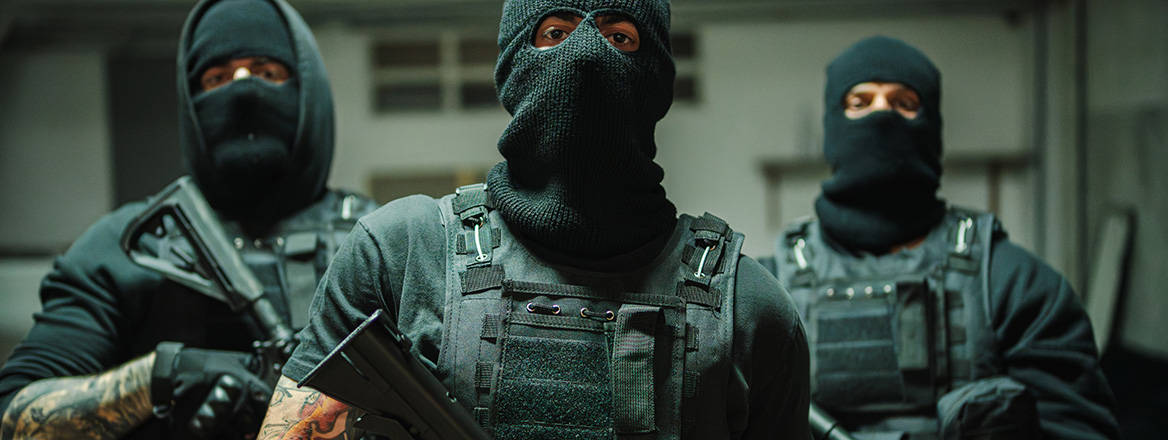Covert Wars, Criminal Gangs, and the ‘New Threat’ Environment
‘Grey Zone’ operations have become a persistent feature of peacetime, upsetting norms of conduct between states in the international community.
In January 2024, the US Department of Justice charged three individuals ‘with conspiracy to use interstate commerce in the commission of a murder-for-hire plot.’ The plot was developed by Iran’s Ministry of Intelligence and Security (MOIS) and targeted an Iranian dissident and his companion. One of the individuals charged was an Iranian drug smuggler, Naji Sharifi Zindashti. The other two individuals were two Canadian citizens. One, Damion Ryan was a member of the outlaw Hells Angels Motorcycle Club. Ryan then contacted another associate, Adam Pearson. According to the BBC reporting, ‘Mr Zindashti…agreed to pay Mr Ryan, 43, and Pearson, 29, a total of $350,000 (£275,000) plus $20,000 (£15,750) in travel expenses for the murder-for-hire.’ Most of the communication took place via the encrypted communication platform SkyECC.
There are, of course, several reasons for the deployment - by Iran, Russia and other states - of these methods of covert action.
First, it can be explained as a matter of expediency, necessity and availability of new technologies.
Second, many of these ventures are both disruptive (for the enemy) and profitable for those involved. Both states and criminal groups stand to gain from the collaboration and not only in financial terms.
Third, these methods help re-establish a veneer of plausible deniability. They move, in fact, beyond the simple use of proxies. Operations can be broken in small, compartmentalised components. Witting and unwitting individuals, with limited or no connection to intelligence agencies, can be recruited via encrypted communications for limited or one-off operations, including sabotage. To paraphrase Mark Galeotti, we are in a new terrain of proxies of proxies of proxies.
Finally, as several commentators have argued, these new methods represent Russia’s response to sanctions and to the expulsion of diplomatic and intelligence personnel. Here, Russia might well have learned from other countries under sanctions regimes, such as Iran. In other words, they represent a response to Western measures in what is – by now – a full-blown covert war between Russia and many Western countries. Taken individually, none of these developments is necessarily unprecedented, but combined they pose a set of novel threats to states and, more broadly, international society.
In this context, RUSI’s Matthew Redhead has suggested that these activities represent episodes of ‘statecraft conducted in bad faith,’ a ‘distortion of commonly used methods.’ Redhead further argues convincingly that certain practices seem to violate accepted ‘rules of the game,’ bending and twisting accepted norms.
States spy on each other and engage in intelligence operations in softer and harder ways, but they rarely seek to annihilate the foundations of diplomatic interaction altogether, or to completely break the ‘rules of the game’
And yet, to a sceptical reader, the idea of norms or ‘rules of the game’ in as controversial a realm as intelligence and covert action might seem somewhat disingenuous. Does understanding intelligence as a realm of rules and norms help us in understanding the current situation? Can emerging intelligence scholarship help?
Intelligence, International Society, and the ‘Rules of the Game’
Recent approaches – coming out of the English School (ES) of International Relations (IR) – highlight how the notion of a covert war between East and West – especially when fought through combinations of these new methods, including criminal gangs – poses a most serious challenge not only to individual states but also to the very fabric of international society.
Clearly, the world of covert operations has always operated in the shadows; as the then-Vice President Dick Cheney remarked in the immediate aftermath of the 9/11 terrorist attacks: sometimes you just have to work ‘sort of the dark side […] in the shadows of the intelligence world’. However, as ES scholarship has repeatedly shown, international relations, have always been governed by both power and norms, that is, rightful expectations of legitimate behaviour, even if these are contested or violated. States spy on each other and engage in intelligence operations in softer and harder ways, but they rarely seek to annihilate the foundations of diplomatic interaction altogether, or to completely break the ‘rules of the game.’
What we are now witnessing is the mutation of intelligence work and covert operations into something that erodes the mutual recognition required for international society to function. If that’s where we are headed – think of the 2024 murder plot against Rheinmetall CEO Armin Pappberger, which was part of a campaign of sabotage by Russia – the policy implications are pressing, and ES theorisation can help make sense of these conceptual and practical challenges.
Three Main Challenges and an International Society Response
First is the problem of international cooperation. It’s a truism to say that transnational threats require cooperation in good faith, especially when dealing with covert capabilities of competitors and adversaries in this murky space where states and syndicates converge, and where distinctions between power, war and crime, and between spies and thugs, begin to dissolve.
From an ES point of view these issues are not sufficiently addressed by multilateral forums. Institutions such as Interpol or the UNODC are largely focused on transnational crime as a law enforcement issue, often sidestepping its instrumentalisation by states for their overt or covert geopolitical ends.
Likewise, intelligence arrangements such as Five Eyes have over time created robust channels for sharing information about state-based threats but far less capacity to coordinate on the criminal infrastructure enabling those threats and vice versa – not to mention the real problem that, at least politically, the Five Eyes have become a point of contention, as the White House seemed to have contemplated kicking Canada out of that very trusted and historically remarkable circle. It is this gap and worrisome politicking that allows states like Iran or Russia (and others) to exploit a rather permissive environment to do as they please.
The second blindspot has to do with how current threats and the states deploying them are exploiting institutional divides within states. More often than not, the cultural and bureaucratic divide between states’ intelligence agencies, civilian or military, and their law enforcement authorities tends to be quite stark.
Spooks typically operate under different legal authorities, with different mandates, levels of secrecy, and above all else, cultures of accountability. Policing may encounter a criminal enterprise linked to geopolitical objectives but lack the remit or the clearance to pursue it as such.
Conversely, spooks may be aware of foreign covert activity enabled or done by criminal networks but do not engage directly in criminal prosecution or disruption. This creates a grey zone where hybrid threats can fester, falling through the cracks of institutional design, bureaucratic practice, and political will.
Third, what is needed is not just more domestic and international cooperation, but an analytical and moral reframing of the very threat. The fusion of organised crime and covert state action against the backdrop of geopolitical interests is not to be seen as merely criminal plots or shady intelligence operations or black ops; rather, they are strategic assaults on the very fabric of international order, let alone operational assaults on open societies and the trust that is required to sustain free and fair elections and the free flow of goods in free markets.
How can the ‘English School’ Help?
ES theorisation can help scholars and practitioners in viewing these assaults not merely through the lenses of counterintelligence or crime control. It can also help in highlighting how confronting these threats goes beyond calls for more resources and more collaboration.
Instead, these new threats can be understood as violations of legitimate international practices. Intelligence has always lived in the shadows – but now, the shadows are getting darker and darker. By reframing the nature of the threats, the toolbox available to policymakers expand.
ES also encourages policymakers to think through and craft new standards of what is acceptable international practice and what is ‘beyond the pale.’ In particular, ES points policymakers attention to a distinction between more pluralist approaches in which states coexist despite deep differences, and solidarist ones, in which states pursue universally shared values.
Understanding where states fall along this pluralism–solidarism spectrum and what can be achieved along this spectrum can help policymakers anticipate other states’ behaviour, craft more realistic policy responses, and assess how and when to reach out to other states in the pursuit of accepted standards.
This approach can also help policymakers in uncovering when past ‘rules of the game’ are being abandoned; as well as what are continuities and discontinuities, as well as elements of friction in states’ practice. It can also help in selecting the right platform, forums (whether bilateral or multilateral), and channels to establish (or reaffirm) norms and standards.
In other words, an approach that recognised the diversity of international society and the evolution of states’ approaches helps policymakers, diplomats, and intelligence professionals fine-tune their norm-setting responses – neither panicked nor complacent. Democracies must defend themselves, without becoming what they oppose.
© Robert Schuett and Luca Trenta, 2025, published by RUSI with permission of the authors.
The views expressed in this Commentary are the authors', and do not represent those of RUSI or any other institution.
For terms of use, see Website Terms and Conditions of Use.
Have an idea for a Commentary you'd like to write for us? Send a short pitch to commentaries@rusi.org and we'll get back to you if it fits into our research interests. View full guidelines for contributors.
WRITTEN BY
Dr Robert Schuett
Guest Contributor
Dr Luca Trenta
Guest Contributor
- Jim McLeanMedia Relations Manager+44 (0)7917 373 069JimMc@rusi.org




